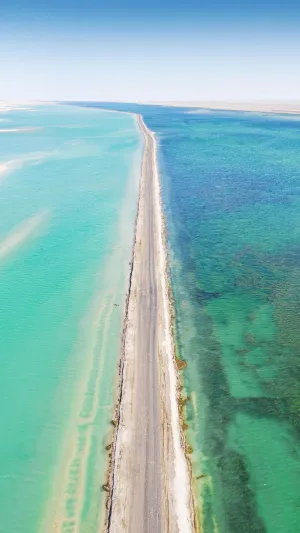Salt, a seemingly ordinary crystal, holds a degree of magic and mystery that surpasses our cognition. On Earth, a unique and magnificent salt lake landform has been created, showcasing the extraordinary beauty and diversity hidden within the salt lakes.
A salt lake, defined as a body of saline water, typically refers to lakes with a salinity greater than 3.5% (exceeding the average salinity of seawater). This category also includes dry brine lakes, where surface brine dries up, leaving behind saline deposits and intergranular brine.
Salt lakes are predominantly found in arid regions and are the result of a lake's evolution to old age.
Contrary to the edible salt found in homes, the salt in these lakes is rich in various salts, including carbonates and sulfates, making it a valuable mineral resource. A body of water is classified as a salt lake only when the soluble salt content exceeds 35 grams per liter. These salt lakes not only provide essential mineral resources but also captivate the world with their breathtaking beauty.
Under clear skies, with the blue expanse and white clouds as a backdrop, salt lakes transform into a mesmerizing kaleidoscope of colors. The sunlight dances upon the lake, creating vibrant hues of green, blue, red, yellow, brown, orange, and white. Even on cloudy days, the deep lakes remain enchanting. Many salt lakes worldwide have become famous tourist destinations, such as the Great Salt Lake in Utah, USA, second only to the Dead Sea in salt content, with the city of Salt Lake City named in its honor.
The salt fields, resembling a massive palette, exhibit different colors under the open sky. The salt lake appears extraordinarily beautiful, especially at noon, as the interaction of seaweed and various minerals gives rise to a colorful spectacle resembling an ocean of hues.
The genesis of this visual feast lies in the causes that lead to the formation of salt lakes. In arid and semi-arid areas, the evaporation of salt lake water surpasses precipitation and recharge, resulting in high salt concentrations. The difference in salinity caused by water evaporation gives rise to various colors in the lake. Salt crystals precipitate on the lake surface, creating intricate lines and joints that, when refracted by light, produce a stunning array of colors.
The vivid colors of salt lakes also originate from the organisms within them, such as halophilic microorganisms and algae. These organisms contribute to the brilliance of the lake's colors. For instance, Rose Lake in Senegal, a West African country bordering the Atlantic Ocean, is renowned for its pink hue. This 3-square-kilometer lake exhibits a particularly charming pink color from December to January, thanks to halophilic microorganisms in the crystallization pool. Surviving in high-salinity brines, these microorganisms have cell membranes containing carotenoid pigments, resulting in the visually striking pink effect.
Remarkably, as the lake's salinity fluctuates, the distribution of these microorganisms varies, leading to different shades of red in the lake. Additionally, factors like the mineral composition of the soil in the salt lake and the water level's depth contribute to the lake's changing colors.
In conclusion, the captivating beauty of salt lakes stems from the interplay of natural elements, from evaporation-induced salinity variations to the presence of unique microorganisms. These factors, combined with the mineral composition of the surroundings, create an ever-changing and stunning palette of colors in salt lakes, making them both a marvel of nature and a source of invaluable resources.





